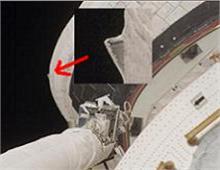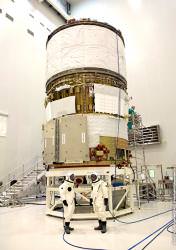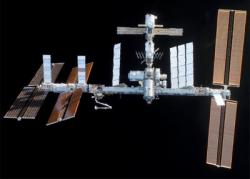A medical issue with a member of the space shuttle crew has forced a change in personnel for the first scheduled spacewalk of the STS-122 shuttle mission to the International Space Station. The switch has also mandated that the spacewalk be delayed one day to Monday. NASA officials would not say which astronaut was experiencing any medical problems, but did confirm that Stan Love has replaced Hans Schlegel for the initial spacewalk.
“There was a medical issue with the crew,” said John Shannon, deputy shuttle program manager. “The flight surgeons do private medical conferences with the crew throughout the mission. The crew called down and asked for one during the rendezvous, which was a little bit of a surprise to us. They talked to the crew members, they understood what the issue was. I will just say it is not going to impact any of the objectives of this mission.”
In video shown on NASA TV, Schlegel showed no noticeable illness as the shuttle crew come on board the ISS after shuttle docking. Reports on news wires suggested that Schlegel lost his voice, but that claim was not corroborated by Shannon.
Communication during the spacewalk would be critical. Schlegel appeared to talk with the ISS crew as he entered the station, and floated easily through the Harmony node. About half of all people who fly in space experience Space Adaptation Syndrome, which include symptoms such as nausea, dizziness and headaches. But citing medical privacy policies, Shannon refused to answer any questions about the nature of the medical issue, or whether Schlegel would be available for the second spacewalk of the mission, now slated for Wednesday.
“You guys can fish all day, but I won’t bite,” Shannon said.
The spacewalk will help install the new Columbus science module, brought up in Atlantis’ payload bay. Installation of the module is the primary goal of this mission.
The shuttle docked at 12:17 pm EST on Saturday. As the shuttle approached the station, the ISS crew took photos of the shuttle to check for any damage to Atlantis. They were asked to take special note of a small tear in the insulation blanket of the Orbital Maneuvering System rocket pod along the tail of the shuttle. Shannon said the tear is probably not critical, but that it’s being looked at.
“Nobody is very excited about this one,” he said. “I don’t expect this to be an issue but the team will continue to work it.”
The insulation blankets on the OMS pods experience temperatures around 700 to 1,000 degrees Fahrenheit during peak heating of re-entry. A similar tear on an earlier shuttle flight was repaired by a spacewalking astronaut using surgical staples. Three spacewalks are planned during Atlantis’ current mission and a staple gun is on board if needed.
On a final note, for any Prairie Home Companion fans out there, the shuttle crew wake-up call on Saturday morning was the Powdermilk Biscuit song.
Original News Source: NASA TV




